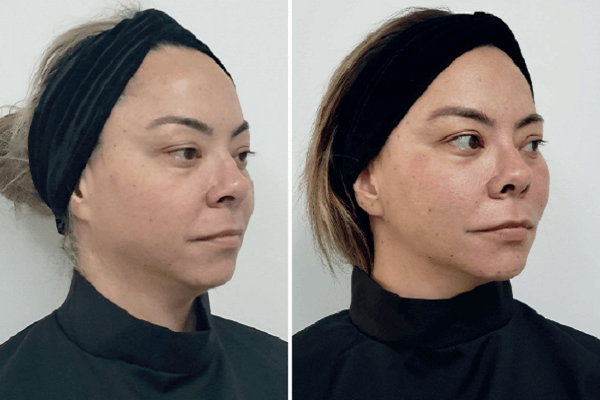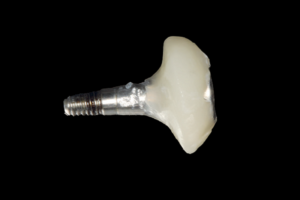AUTORES
Emanuelle Teixeira Carrera
Cirurgiã-dentista – FOA/Unesp; Mestrado em Dentística Restauradora (Ciências Odontológicas) – Unesp; Especialista em Harmonização Orofacial – Instituto Thoppi. Orcid: 0000-0002-8074-9518.
Carina de Almeida Braga
Cirurgiã-dentista – Universidade de Franca; Especialista em Harmonização Orofacial – Instituto Thoppi. Orcid: 0000-0003-3666-8953.
Eduardo Antônio de Castro Vieira
Cirurgião-dentista – Universidade Vale do Rio Verde de Três Corações; Especialista em Prótese Dentária – Unicamp. Orcid: 0000-0002-8265-4766.
Patrícia Guedes Maciel Vieira
Cirurgiã-dentista – Universidade Vale do Rio Verde de Três Corações; Doutorado em Odontologia – UFMG. Orcid: 0000-0001-6959-7675.
RESUMO
A busca por procedimentos estéticos não invasivos tem crescido muito na Harmonização Orofacial. E o preenchedor com ácido hialurônico tem sido o eleito para estes procedimentos, por apresentar uma boa integração com os tecidos da pele e ser uma substância semelhante ao ácido hialurônico presente no ser humano. Porém, não é totalmente ausente de riscos, seja por inexperiência do profissional, escolha de material inadequado para área de aplicação ou até mesmo variação anatômica. Entre os efeitos adversos, pode haver a formação de nódulos ou até reação granulomatosa. Para corrigir estes efeitos, podemos fazer uso da hialuronidase. O objetivo deste trabalho foi apresentar o uso da hialuronidase para a resolução de nódulos tardios após preenchimento de olheiras.
Palavras-chave – Ácido hialurônico; Estética; Preenchedores dérmicos; Hialuronoglucosaminidase; Efeitos adversos.
ABSTRACT
The search for non-invasive aesthetic procedures has grown a lot in orofacial harmonization. The filler with hyaluronic acid has been chosen for these procedures, as it has a good integration with the skin tissues and is a substance similar to the hyaluronic acid present in humans. However, it is not entirely absent of risks, due to the lack of professional experience, choice of inappropriate material for the application area or even anatomical variation. Among the adverse effects, there may be the formation of nodules or even a granulomatous reaction. To correct these situations, we can make use of hyaluronidase. Thus, the purpose of the work was to present the use of hyaluronidase for resolution of late nodules, after filling of hollow eyes.
Key words – Hyaluronic acid; Esthetics; Dermal fillers; Hyaluronoglucosaminidase; Adverse effects.
Referências
- Silva Neto JMA, Calado JLT, Melo MHAS, Neto JFT. Hialuronidase: uma necessidade de todo cirurgião dentista que aplica ácido hialurônico injetável. REAS 2020;39(e2296):1-19.
- Percec I, Bertucci V, Solish N, Wagner T, Nogueira A, Mashburn J. An objective, quantitative, dynamic assessment of hyaluronic acid fillers that adapt to facial movement. Plast Reconstr Surg 2020;145(2):295e-305e.
- Crocco EI, Alves RO, Alessi C. Adverse events in injectable hyaluronic acid. Surg Cosmet Dermatol 2012;4(3):259-63.
- Neri SRNG, Addor FAZ, Parada MB, Schalka S. The use of hyaluronidase in complications caused by hyaluronic acid for volumization of the face: a case report. Surg Cosmet Dermatol 2013;5(4):364-6.
- Costa A, Coletta LCD, Talarico AS, Fidelis MC, Weimann ETS. Características reológicas de preenchedores dérmicos à base de ácido hialurônico antes a após passagem através de agulhas. Surg Cosmet Dermatol 2013;5(1):88-91.
- Buhren BA, Schrumpf, Bolke E, Kammers K, Gerber PA. Standardized in vitro analysis of the degradability of hyaluronic acid fillers by hyaluronidase. Eur J Med Res 2018;23(1):37.
- Fagien S, Bertuccci V, von Grote E, Mashburn JH. Rheologic and physicochemical properties used to differentiate injectable hyaluronic acid filler products. Plast Reconstr Surg 2019;143(4):707-20.
- Tezel A, Fredrickson GH. The science of hyaluronic acid dermal fillers. J Cosmet Laser Ther 2008;10(1):35-42.
- Beasley K, Weiss MA, Weiss RA. Hyaluronic acid fillers: a comprehensive review. Facial Plast Surg 2009;25(2):86-94.
- Flynn TC, Sarazin D, Bezzola A, Terrani C, Micheels P. Comparative histology of intradermal implantation of mono and biphasic hyaluronic acid fillers. Dermatol Surg 2011;37(5):637-43.
- Herrera YLR, Bracchini JJM, Molinar l, Jorge DL, Hesles HG. Hallazgos histopatológicos em la dermis después de la aplicación de ácido hialurónico monofásico versus bifásico. Otorrinolaringología 2013;58(3):134-8.
- Solish N. Fillers: what’s here and what’s ahead. Semin Cutan Med Surg 2016;35(6):117-9.
- Micheels P, Sarazin D, Tran C, Salomon D. Effect of different crosslinking technologies on hyaluronic acid behavior: a visual and microscopic study of seven hyaluronic acid gels. J Drugs Dermatol 2016;15(5):600-6.
- Hee CK, Shumate GT, Narurkar V, Bernardin ADJ, Messina DJ. Rheological properties and in vivo performance characteristics of soft tissue fillers. Dermatol Surg 2015;41(suppl.1):373-81.
- Lee A, Grummer SE, Kriegel D, Marmur E. Hyaluronidase. Dermatol Surg 2010;36(7):1071-7.
- Dunn AL, Heavner JE, Racz G, Day M. Hyaluronidase: a review of approved formulations, indications and off-label use in chronic pain management. Expert Opin Biol Ther 2010;10(1):127-31.
- de Almeida ART, Saliba AFN. Hyaluronidase in cosmiatry: what should we know? Surg Cosmet Dermatol 2015;7(3):197-204.
- Soparkar CN, Patrinely JR, Tschen J. Erasing restylane. Ophthalmic Plast Reconstr Surg 2004;20(4):317-8.
- Sclafani AP, Fagien S. Treatment of injectable soft tissue filler complications. Dermatol Surg 2009;35(2):1672-80.
- Weber GC, Buhren BA, Schrumpf H, Wohlrab J, Gerber PA. Clinical applications of hyaluronidase. Adv Exp Med Biol 2019;1148:255-77.





